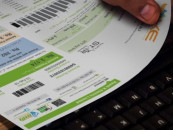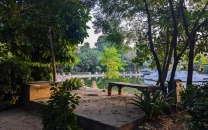Pimp my (peaceful) rickshaw
Armed with messages of peace, the Pakistan Youth Alliance is set to send out 50 rickshaws into the streets of Karachi.

Armed with messages of peace, the Pakistan Youth Alliance is set to send out 50 rickshaws into the streets of Karachi.
Over the years, rickshaws have been used for everything from advertising television shows to spreading hateful messages against India courtesy of the Jamaatud Dawa and other groups. Both inspired and alarmed by this latter phenomenon, an enterprising group of youngster calling themselves the Pakistan Youth Alliance (PYA) decided to counter the messages of hate by designing rickshaws around the theme of peace.

The PYA plans to send out 50 rickshaws — refurbished and emblazoned with a message of peace into the streets of Karachi. Five of these rickshaws have already been redesigned at Nusrat Iqbal’s chamak patti workshop in Sohrab Goth. Iqbal is the man who designed the W-11 buses being displayed across the world and also has a decorating commission in Dubai to his credit. He agreed to take on the project as a ‘good deed’.
The pimped up rickshaws scream for attention. Decorated in the truck art style, the rickshaws are not adorned with the usual poetry about love, spirituality, women and flowers but instead bear a message of peace. Mohammad Tariq Shah, who has been driving a rickshaw for around six months, is now behind the wheel of an eye-popping fuchsia rickshaw with the potent slogan: ‘Rickshaw chala raha hoon, goli to nahin!’ (I’m driving a rickshaw, not firing a bullet). Another rickshaw’s cover has been replaced with a print of an Urdu newspaper’s editorial page; with headlines like ‘deen mai jabar nahi’ (there is no oppression in religion).
“We wanted to counter extremism by using art as a medium. Rickshaws are always on the go, everyone sees them,” says Maria Naqvi, the director of art and advocacy for the PYA.

The PYA doesn’t take credit for the designs and the slogans though; these were decided by children from government schools all over Karachi, who were part of a workshop that preceded the rickshaws project. “We talked to them about the problems in their area and in the country. We were amazed at how much they knew about the ground realities,” Naqvi says, “they knew words like ‘firqa variyat’ (sectarianism).”
Over the course of the workshop, the students came up with the catchphrases, playing on existing slogans and advertisements like: ‘Pappu yaar jang na kar’ and ‘aman ko phaila dala to life jhingalala’.
Though the jazzed up rickshaws have only been on the road for a few weeks, people are already showing interest. Curious rickshaw drivers have approached Iqbal to redo their rickshaws in the same style. “It has become more beautiful than before,” Shah says of his newly refurbished ride, “the other day I had a Pathan passenger who claimed that there wasn’t another rickshaw like this in all of Karachi!” A pick-up driver also approached Iqbal, and said that he wanted the same peace messaging since he travelled throughout the country. This is exactly what PYA co-founder Maryam Kanwer hopes to achieve — that the slogans go viral and spread the message of peace.

The drivers of the five redesigned rickshaws come from what Kanwer describes as the ‘conflicted areas’ of Lyari, North Karachi, Korangi and North Nazimabad. The drivers were found via a member of the organisation; one was a distant relative, who brought along a cousin, and thus the word spread. Naqvi says that they picked rickshaws that operated in different parts of the city, and ones that were pretty rundown to begin with. Each rickshaw cost Rs6,000 to Rs10,000 to redesign and to refurbish, and if you haven’t spotted one yet don’t worry, the PYA is planning a peace march in the coming months which will feature all the rickshaws and the students from the workshops along with (hopefully) the citizens of Karachi.
The PYA is very careful in terms of the messages they put on the rickshaws as they can be easily misconstrued. “We understand the concerns of the rickshaw drivers,” Naqvi said, “one of them, whose rickshaw has ‘aman’ [peace] written on it, got threats from some Pathans in Lyari who thought that this was a message from the People’s Aman Committee!”
But can five or even 50 rickshaws counter the messages of hate being spread by other groups, who have more resources, manpower and reach than the PYA? Kanwer believes they can. “I have faith that even in the darkness there is light,” she says.
The PYA is not alone, and over the past few years the deepening crisis in the country has served as an inspiration for local artists, who are actively trying to spread the message of peace through t-shirts, street art and paintings. Kanwer’s faith is also shared by the rickshaw drivers, who are excited about spreading peace and, of course, about the shiny, happy interior of the vehicles. They hope that this will not just attract customers — “people turn around and stare at the rickshaws in traffic,” says one driver — but also help change people’s mindsets.

One of the drivers of the rickshaws, Mohammad Yousaf, best describes their intentions with a Seraiki poem from his childhood:
‘Wafadar haan mai wafadar rahsaan,
Wafavah di nagri da sardar haan
Aman wandawan gunah hai jai kar
Gunahgaar haan mai gunahgaar haan’
‘I am loyal,
the lord of all those who are loyal.
If spreading peace is a sin,
then I am a sinner’
Published in The Express Tribune, Sunday Magazine, February 10th, 2013.
Like Express Tribune Magazine on Facebook to stay informed and join the conversation.
Correction: An earlier version of the article had incorrectly translated the word 'jabar'. The error has been rectified.



















COMMENTS
Comments are moderated and generally will be posted if they are on-topic and not abusive.
For more information, please see our Comments FAQ